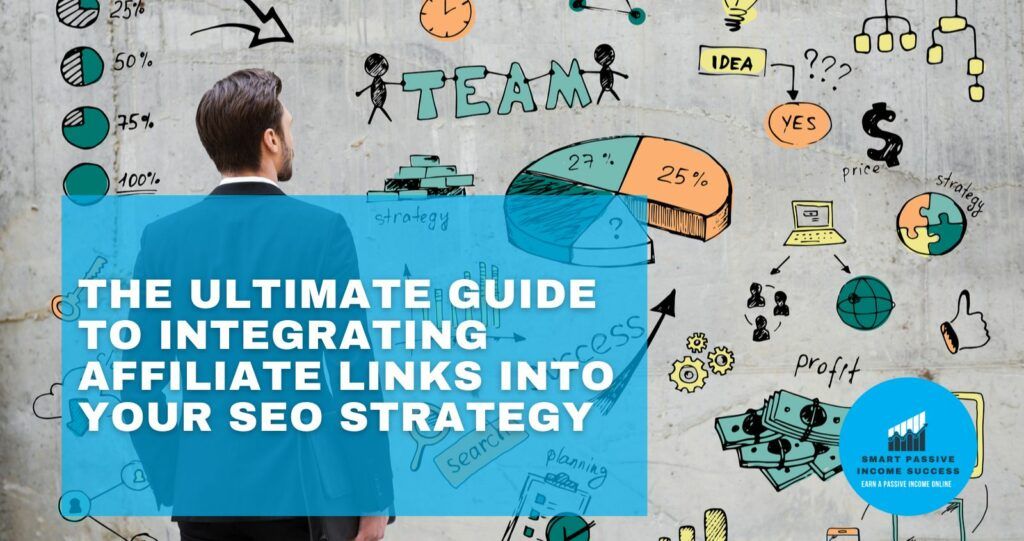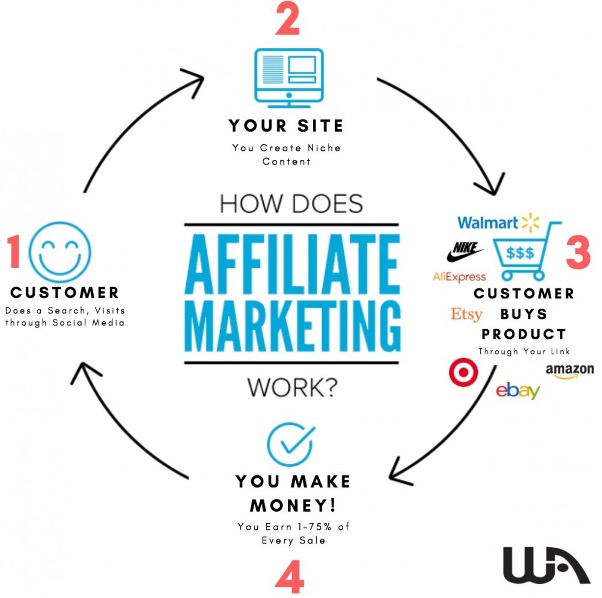Are you looking for ways to monetise your website while boosting your search engine rankings? If so, incorporating affiliate links into your SEO strategy could be the answer you’ve been searching for.
By partnering with reputable affiliate programs and strategically integrating affiliate links into your content, you can earn commissions while providing value to your audience.
However, it’s important to approach affiliate marketing with a thoughtful and strategic mindset, as haphazardly throwing in affiliate links can do more harm than good.
In this ultimate guide, we’ll walk you through the best practices for integrating affiliate links into your SEO strategy, from choosing the right programs and products for your audience to optimising your content for maximum conversions. Let’s dive in!
Table of Contents
Understanding Affiliate Marketing
What is Affiliate Marketing?
Affiliate marketing is a type of online marketing where an affiliate (publisher) earns a commission by promoting products or services of a company (merchant).
The affiliate earns a commission when a customer makes a purchase through their unique affiliate link. The link tracks the referral and ensures that the affiliate receives credit for the sale.
The commission rate can vary depending on the program, product or service being promoted, and the agreement between the merchant and the affiliate.
Affiliate marketing is a popular way for bloggers, influencers, and website owners to monetise their online presence and for merchants to drive traffic and sales to their businesses.
There are many different ways of making money through affiliate marketing. Which we will discuss with you now…
The Different Types of Affiliate Marketing Programs
There are several different types of affiliate marketing programs, each with its own unique features and benefits. Here are some of the most common types:
Pay-per-click (PPC) – In this model, affiliates earn a commission every time a user clicks on an affiliate link and is redirected to the merchant’s website. The commission is typically small, but the volume of clicks can make up for it.
Pay-per-lead (PPL) – This model pays affiliates for each lead they generate for the merchant. A lead can be a completed form, a sign-up for a free trial, or any other action that indicates a potential customer’s interest in the merchant’s product or service.
Pay-per-sale (PPS) – This is the most common type of affiliate program, where affiliates earn a commission for every sale made through their affiliate link. The commission can be a percentage of the sale price or a flat fee.
Two-Tier Affiliate Program – In this model, affiliates earn commissions not only for the sales they generate but also for the sales generated by other affiliates they refer to the program. This creates a multi-level marketing structure that can be very lucrative for top performers.
Multi-Level Marketing (MLM) – In this model, affiliates not only earn commissions for the sales they generate but also for the sales generated by the affiliates they recruit into the program. This creates a network of affiliates who are incentivised to recruit more affiliates and drive sales.
Influencer Marketing – This is a newer type of affiliate program that is focused on leveraging the influence of social media influencers to drive sales. Influencers are typically paid a commission for any sales they generate through their social media posts or other promotional activities.
Each type of affiliate marketing program has its own strengths and weaknesses, and choosing the right one will depend on your goals and the specific niche you are operating.
Examples of Successful Affiliate Marketing Campaigns
Here are a few examples of successful affiliate marketing campaigns:
Amazon Associates – Amazon’s affiliate program, known as Amazon Associates, is one of the most successful affiliate marketing programs in the world. Affiliates can earn commissions by promoting any of the millions of products available on Amazon, and many bloggers and websites use Amazon Associates to monetize their content.
Shopify Affiliate Program – Shopify’s affiliate program offers affiliates a generous commission rate for promoting its e-commerce platform. Affiliates can earn up to $2,000 for each new Shopify Plus customer they refer, making it a lucrative option for those in the e-commerce niche.
Bluehost Affiliate Program – Bluehost’s affiliate program offers affiliates a $65 commission for each new customer they refer to the web hosting service. Bluehost is a popular choice for bloggers and website owners, and the generous commission rate has helped the company grow its user base through affiliate marketing.
Booking.com Affiliate Program – Booking.com’s affiliate program offers affiliates a commission on every booking made through their referral link. With over 28 million listings worldwide, Booking.com is a popular choice for affiliates in the travel niche.
ClickFunnels Affiliate Program – ClickFunnels offers a generous commission rate to affiliates who promote its sales funnel builder software. Affiliates can earn up to 40% commission on each sale, and many top affiliates have earned six or seven-figure incomes promoting ClickFunnels.
These are just a few examples of successful affiliate marketing campaigns, but there are many more out there. The key to success in affiliate marketing is to find the right program for your niche and audience and to promote it effectively through content marketing, social media, email marketing, and other channels.
SEO Best Practices for Affiliate Marketing

Incorporating affiliate links into your SEO strategy can be tricky because search engines like Google have strict guidelines about how links should be used on websites.
If you use affiliate links improperly, it can hurt your search engine rankings and cause your website to be penalised or even de-indexed.
Here are some tips for incorporating affiliate links into your SEO strategy without hurting your search engine rankings:
Use Nofollow Links – One of the best ways to avoid being penalised for affiliate links is to use the nofollow attribute when linking to affiliate products. A nofollow link tells search engines not to pass link equity to the linked page, which means that it won’t affect the linked page’s rankings. By using nofollow links for affiliate links, you can avoid the risk of being penalised for unnatural link building.
Use Natural Anchor Text – When linking to affiliate products, it’s important to use natural, descriptive anchor text that accurately reflects the linked page’s content. Avoid using generic or spammy anchor text like “click here” or “buy now,” as this can raise red flags for search engines and hurt your rankings.
Use Contextual Links – Contextual links are links that are embedded within relevant content, such as product reviews or blog posts. By using contextual links to promote affiliate products, you can avoid the appearance of spammy or irrelevant links, which can hurt your search engine rankings.
Disclose Affiliate Relationships – It’s important to disclose your affiliate relationships to your readers and followers. This not only builds trust with your audience but also helps you stay compliant with FTC guidelines about affiliate marketing. You can include a disclosure statement on your website or social media profiles to let your audience know that you may receive a commission for products you recommend.
Focus on High-Quality Content – Ultimately, the best way to incorporate affiliate links into your SEO strategy without hurting your search engine rankings is to focus on creating high-quality, valuable content that provides real value to your audience. By creating content that people want to read and share, you can naturally attract links and drive traffic to your affiliate products without resorting to spammy or manipulative tactics.
I could go on, but if you want to understand more about some of the most common mistakes people make regarding their SEO campaigns, read my complete guide on how to avoid them.
How to Choose Affiliate Programs & Products

Choosing the right affiliate programs and products for your niche and audience is essential to the success of your affiliate marketing efforts.
Here are some steps to help you make the right choices:
Identify your Niche – Start by identifying your niche and the topics you will be writing about. This will help you narrow down your options and focus on affiliate programs and products that are relevant to your audience.
Research Affiliate Programs – Research affiliate programs in your niche and compare their commission rates, payment methods, and other important factors. Look for programs that have a good reputation, offer high-quality products, and have a track record of paying their affiliates on time.
Evaluate Products – Once you have identified some potential affiliate programs, evaluate the products they offer. Look for products that are high-quality, relevant to your audience, and offer good value for money. You may also want to consider the price point of the products and whether they are something your audience is likely to buy.
Consider your Audience – When choosing affiliate products, it’s important to consider your audience’s needs, interests, and preferences. Think about what types of products your audience is likely to be interested in and what problems they are trying to solve.
Test and Refine – Once you have selected some affiliate programs and products, start testing them on your website or blog. Pay attention to which products are generating the most clicks, conversions, and revenue, and refine your approach accordingly.
By following these steps, you can choose the right affiliate programs and products for your niche and audience, and build a successful affiliate marketing business over time.
How to Measure Affiliate Marketing Success
Measuring the success of your affiliate marketing efforts is essential to understanding how well your strategies are working and where you can make improvements. Here are some key metrics to track:
Click-Through Rates (CTR) – This is the percentage of people who click on your affiliate link compared to the number of people who view it. CTR can help you gauge the effectiveness of your call-to-action and the relevance of your content to your audience.
Conversion Rates – This is the percentage of people who complete a desired action, such as making a purchase, after clicking on your affiliate link. Conversion rates can help you assess the quality of your traffic and the effectiveness of your landing pages.
Revenue – This is the amount of money you earn from your affiliate marketing efforts. Revenue can help you understand the profitability of your campaigns and the return on investment (ROI) of your advertising spend.
To measure these metrics, you can use tracking tools such as Google Analytics, affiliate network reports, and your own sales data. Here are some tips for using these tools effectively:
Set Up Tracking – Make sure you have tracking codes and cookies installed on your website so you can track clicks and conversions.
Use UTM Codes – Use UTM codes to track traffic from specific campaigns and channels so you can see which sources are generating the most clicks and conversions.
Analyse Data Regularly – Analyse your data on a regular basis to identify trends and make adjustments to your strategies as needed.
Optimise Landing Pages – Test and optimise your landing pages to improve conversion rates and generate more revenue.
By tracking these metrics and making data-driven decisions, you can optimise your affiliate marketing efforts for success and achieve your goals over time.
This is a useful video that might give you a better insight into measuring your affiliate marketing campaigns…
Integrating Affiliate Links into Your Strategy: Conclusion
In conclusion, integrating affiliate links into your SEO strategy can be a powerful way to monetise your website while providing valuable content to your audience. However, it’s important to do so in a way that is ethical, transparent, and beneficial to both your audience and your business.
By following the tips and best practices outlined in this guide, you can create a sustainable affiliate marketing strategy that enhances your SEO efforts, builds trust with your audience, and drives revenue for your business.
Remember to continuously analyse your data, test new strategies, and stay up-to-date on the latest trends in affiliate marketing to ensure long-term success. With dedication and hard work, you can become a successful affiliate marketer and achieve your business goals.
Thanks for checking out my blog post! I hope you found it useful… If you still have any questions or want to add some insights, please write them in the comments section. I would love to hear what you have to say about my guide!
If you feel up to sharing it, then please do. 😉







